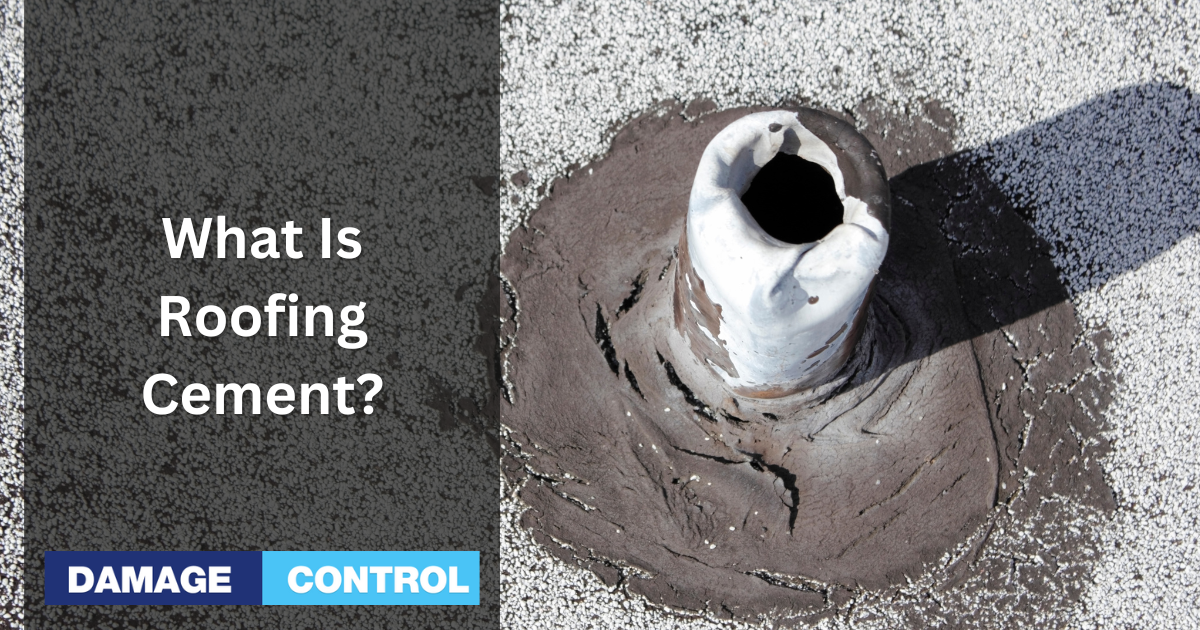Roofing cement, often known as roof sealant or mastic, is a highly viscous compound that provides a robust, waterproof seal to guard your roof against environmental damage. In this comprehensive guide, we'll delve into everything you need to understand about roofing cement and its myriad applications.
The Unmatched Benefits of Roofing Cement
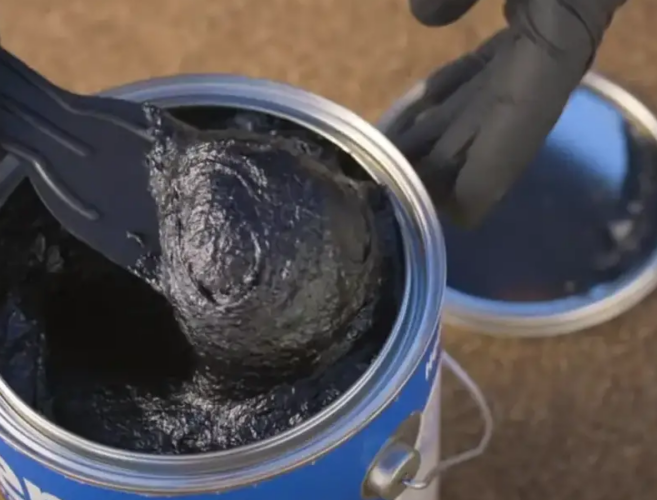
Choosing roofing cement as your preferred choice for sealing and mending roofs ushers in an array of unparalleled benefits. This highly adaptable material rises above many alternatives due to its exceptional properties. The fundamental advantages of roofing cement, each contributing to its wide applicability in a diverse array of roofing needs, are highlighted below:
Comprehensive Waterproof Shield
One of the distinctive characteristics of roofing cement is its unmatched ability to create a comprehensive, waterproof shield. This robust barrier safeguards against water and moisture, effectively mitigating the risk of leaks. The prevention of leaks not only guards the interior of your property but also protects your roof's structural integrity from water-induced damage.
Exceptional Durability
Designed and formulated to resist the most stringent environmental conditions, roofing cement offers remarkable durability. This longevity ensures that the protective barrier it creates remains effective for years to come, providing peace of mind that your roof can withstand the elements, from the harshest winter snow to the intense summer heat.
Adaptability Across Roofing Materials
Roofing cement is hailed for its impressive versatility. It is compatible with a wide range of roofing materials, from traditional asphalt shingles to modern concrete slabs, and even metal roofs. This wide-ranging applicability makes it a go-to solution for various roofing needs.
Little-known Added Value: Energy Efficiency
A lesser-known but equally significant advantage of roofing cement is its contribution to energy efficiency. When applied effectively, roofing cement can seal air leaks and prevent thermal energy transfer, helping to maintain a consistent temperature within the building. This temperature control can lead to significant savings on heating and cooling costs, adding an economic dimension to the physical protection it provides.
An In-Depth Examination of Roofing Cement Varieties
The roofing cement landscape is diverse, offering a range of products, each designed with specific characteristics and uses, just like other sealants for various roofing materials. These varieties cater to a broad spectrum of roofing needs. Here, we'll delve into the details of the principal types of roofing cement and their unique advantages. You can generally buy these products in two forms. One is buckets, where one or five gallons, or in caulking tubes.
Caulking tubes make for cleaner and more detailed applications. The gallon or larger buckets are usually applied best with a small trowel and are best for larger, more difficult locations with leaks.
Plastic Roof Cement
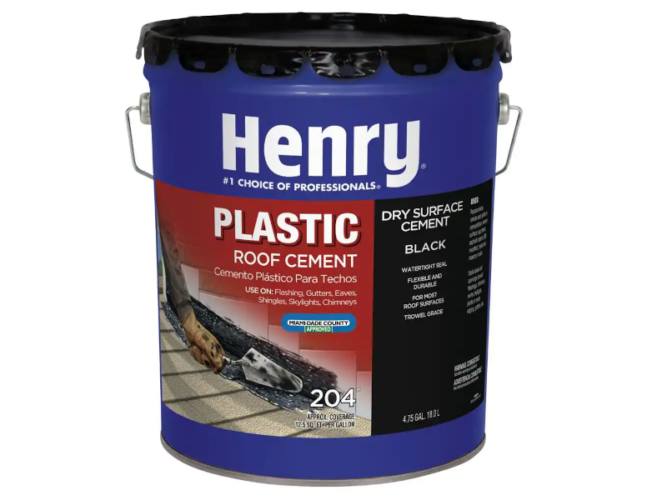
Plastic roof cement stands out as a highly reliable solution for addressing minor imperfections like small cracks and holes. It boasts a heavy-bodied composition, providing it with the tenacity needed to fill gaps and prevent leaks effectively. In addition to remedying these minor issues, it plays a crucial role in sealing and protecting the roof's exposed regions.
A distinct feature of plastic roof cement is its strong adhesive property. It clings powerfully to roofing materials, ensuring a firm hold that withstands weather conditions. Moreover, plastic roof cement offers flexibility, accommodating the natural expansion and contraction of the roof with temperature fluctuations. This dynamic nature prevents cracking and boosts longevity.
Wet Patch Roof Cement
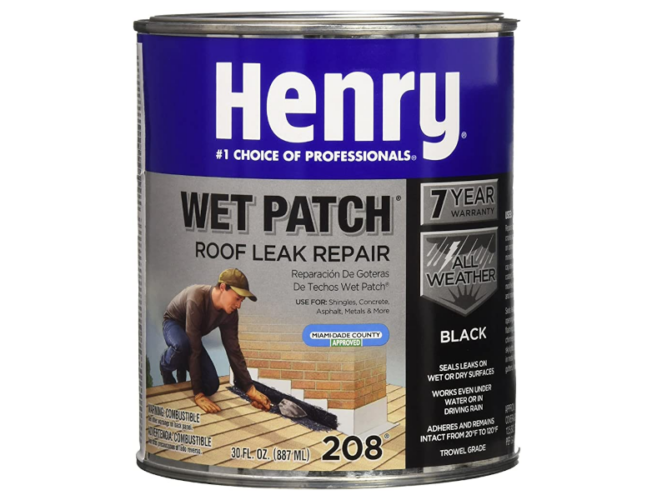
Wet patch roof cement is a unique product designed for the most challenging weather scenarios. This cement type has an impressive ability to adhere to wet surfaces, allowing for application during unfavorable weather conditions.
Whether it's an unexpected roof leak during a downpour or a snowy day, wet patch roof cement comes to the rescue. It boasts a fast-acting formula that provides an immediate seal, mitigating damage from ongoing leaks. It is worth noting that, despite its quick-fix nature, it doesn't compromise on durability, providing a repair that lasts.
All-Weather Roof Cement
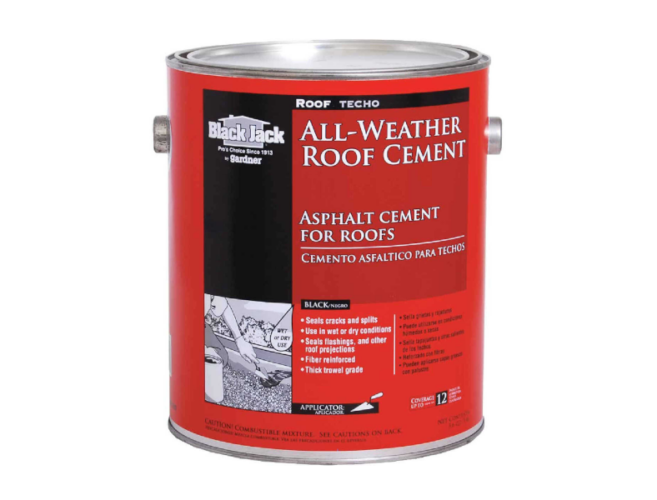
All-weather roof cement is the epitome of versatility when it comes to weather resistance. As the name implies, this cement variant can withstand all weather conditions, making it a universal choice, and suitable for various climates.
All-weather roof cement exhibits excellent adherence to both dry and wet surfaces. This cement retains its adhesive properties and durability regardless of the summer heat or the winter chill. This resilience is its standout feature, making it a sound choice for areas subject to extreme or fluctuating weather conditions.
Finally, all-weather roof cement also offers a high degree of flexibility, maintaining its integrity amidst temperature-driven expansion and contraction. This quality helps prevent the formation of cracks over time, thereby ensuring that the seal remains intact, no matter the weather conditions.
How to Apply Roofing Cement: An Easy-to-Follow Guide
Applying roofing cement, while straightforward, necessitates attention to detail. Below, we outline a step-by-step guide on how to do it efficiently.
Step 1: Clean the Surface
Start by cleaning the roof surface. Remove debris and dust to ensure proper adhesion of the cement.
Step 2: Prime the Surface
Apply a primer to the roof if required by the cement manufacturer. This helps to enhance the bond between the roof surface and the cement.
Step 3: Apply the Cement
Use a trowel or roofing brush to apply a generous layer of cement on the area that needs repair or sealing. Make sure to cover the entire area adequately.
Step 4: Spread and Smooth
Spread the cement evenly across the surface and smooth it out. Ensure it covers the area thoroughly and evenly.
Step 5: Let it Dry
Allow sufficient time for the roofing cement to dry completely. Depending on the specific product and weather conditions, this can take several hours to a full day.
We hope this guide provides a comprehensive understanding of roofing cement. Remember, proper application and choosing the right type of cement for your specific needs is key to ensuring the longevity and robustness of your roof.
Safety Protocols for Applying Roofing Cement
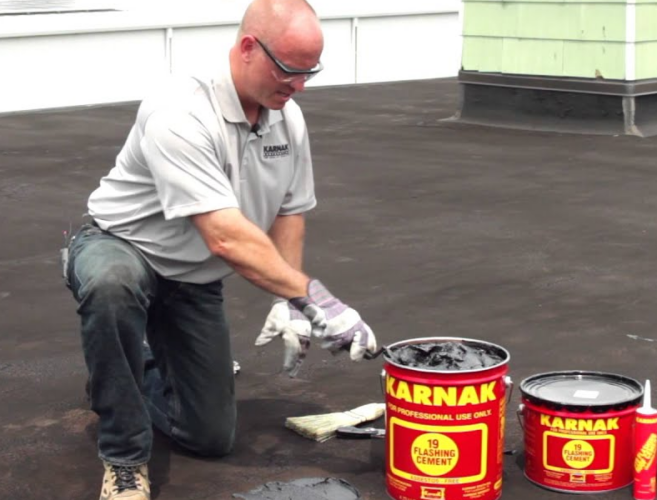
Ensuring safety when working with roofing cement is paramount. As with any construction or repair task, specific safety measures are critical to avoid mishaps and guarantee an efficient, hazard-free application process. Let's delve deeper into the essential safety practices and provide valuable tips to enhance your safety during the roofing cement application.
Emphasis on Protective Gear
The importance of wearing protective gear while working with roofing cement cannot be overstated. It's well known within roofers' circles that if you get one small dab of any type of roofing cement on you, it will spread everywhere. It's likely the best teacher of how easily viruses are spread because its dark color lets everyone know what was touched by it.
It doesn't come off of your skin easily, either. You'll need to have a commercial hand cleaner such as Go-Jo (Citrus is best) to remove it from your skin. There's a reason we push protective gear with this.
Here is a more detailed look at the essential equipment:
- Safety Glasses: Cement particles and fumes can cause serious eye irritation or injury. Safety glasses offer a protective barrier, ensuring your eyes remain safe during the process.
- Work Gloves: Protect your hands with heavy-duty work gloves. Besides preventing direct skin contact with the cement, gloves provide a better grip on your tools, enhancing control during application.
- Long-Sleeved Shirt and Long Pants: They shield your skin from potential cement splashes. Opt for durable and easily washable materials.
- Respirator Mask: Some types of roofing cement release fumes, especially in enclosed spaces. Using a respirator mask can help prevent inhalation of these fumes, protecting your respiratory health.
Adequate Ventilation: More than Just Comfort
While ventilation is often seen as a measure to prevent discomfort from cement fumes, it plays a much more significant role in safety. In enclosed spaces, fumes can accumulate and pose a risk of respiratory complications. An adequately ventilated workspace dissipates these fumes, maintaining a safer breathing environment.
For indoor projects, open all windows and doors, and if available, use fans to circulate the air. When working outdoors, be mindful of the wind direction to stay upwind of fumes.
Responsible Disposal: A Civic Duty
The disposal of leftover roofing cement and empty containers is not only a matter of following regulations. It's about ensuring environmental safety and demonstrating responsible behavior.
Unused roofing cement should never be poured into drains, toilets, or natural bodies of water. The chemicals can harm water systems and contribute to pollution. Instead, let the leftover cement dry out in the can, then dispose of it per local waste management regulations. The same goes for empty cement containers.
A Tip on Ladder Safety
When working on roofs, ladder safety is a critical, yet often overlooked aspect. Always ensure the ladder is stable before climbing. Use a ladder with non-slip feet and extend it at least three feet above the edge of the roof for safe climbing. If possible, have someone spot you while you're on the ladder.
Implementing these safety measures while working with roofing cement can significantly reduce the risk of accidents and health hazards. It's important to remember that taking the time to prioritize safety always pays off in the end.
Maximizing the Life of Your Roof with Roofing Cement
Roofing cement can significantly extend the life of your roof if applied correctly. Here are some tips to get the most out of your roofing cement application:
Regular Inspection
Regular roof inspections can help detect potential issues early. Look out for signs of wear and tear, cracks, and leaks, and address them promptly with roofing cement.
Maintenance
Ensure proper roof maintenance by cleaning it regularly and keeping gutters free from debris. This can prevent water accumulation and subsequent damage.
Professional Help
If the repair is extensive or if you're unsure about the process, don't hesitate to seek professional help. Hiring a roofing professional will guarantee the job is done correctly and safely. Nobody wants a pool party in their living room at 2 AM from a passing thunderstorm.
Frequently Asked Questions About Roofing Cement
To round off this guide, let's address some commonly asked questions about roofing cement.
Can Roofing Cement be Painted Over?
Yes, roofing cement can be painted over. However, ensure the cement is fully cured before applying paint. Use high-quality, acrylic-based paint for best results.
How Long Does Roofing Cement Take to Dry?
The drying time for roofing cement varies based on the type of cement and the environmental conditions. However, on average, it usually takes between 24 to 48 hours.
Is Roofing Cement Toxic?
While roofing cement is not typically considered toxic, it can cause skin irritation and eye discomfort. Always use protective gear when working with roofing cement and ensure the work area is well-ventilated.
In conclusion, roofing cement is a versatile and essential tool in roof maintenance and repair. By choosing the right type of cement, applying it correctly, and observing the necessary safety precautions, you can prolong the life of your roof and keep your property safe from weather-related damage.
As we wrap up this comprehensive guide on the importance and safe application of roofing cement, we invite you to explore more about maintaining your roof and home's overall integrity. Your education shouldn't stop here. Stay proactive and learn how to combat common household problems with our extensive resource library.
Have you ever wondered about the impact of water damage on your roof and home? Don't wait for a crisis to occur. Be informed and ready to take immediate action if necessary. Dive into our guide on Professional Water Damage Restoration in Orlando to understand the process, from identifying the signs of water damage to how professionals can help restore your home.
Furthermore, moisture-related issues can often lead to an unwanted guest in your home: mold. By learning about mold prevention, detection, and remediation, you can ensure your living environment remains safe and healthy. Our Orlando Mold Remediation & Testing Specialists guide covers these topics in detail, equipping you with valuable insights to tackle mold-related issues confidently.
We believe that knowledge is power, and a well-informed homeowner is better equipped to make decisions that protect their home and enhance its longevity. So, don't stop here. Keep reading, keep learning, and remember, we're here to support you every step of the way.

